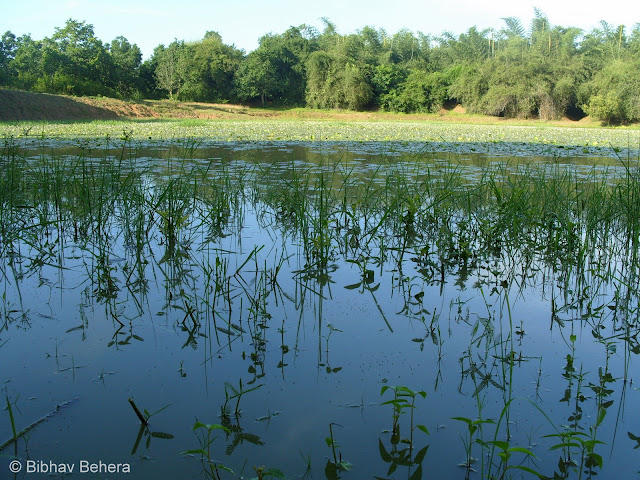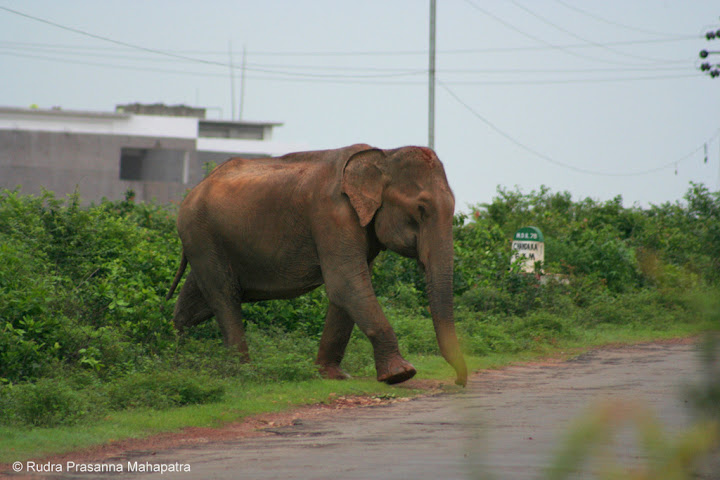Chandaka Damapada Sanctuary: 193.39 sq. kms of the Chandaka forest on the outskirts of Bhubaneswar in the Khurda Uplands were designated as an Elephant Reserve in August 1982. The Sanctuary was marked out to check and restore the depleting forest cover which once covered Bhubaneswar. It is home to 30 species of mammals, 27 species of reptiles and 120 species of birds. The forest cover is mostly bamboo with presence of trees like sal in a few places. The sanctuary has 67 elephants (2007 census) in its approximately 200 sq km area.
As per the All Orissa Elephant Census 2007 report, the Chandaka Damapada Sanctuary has:
Total Sanctuary Area: 193.39 sq kms.
Adult Bulls: 09 (8 Tuskers and 1 Makhna)
Adult Cows: 22
Sub-Adult Bulls: 05 (5 Tuskers and 0 Makhna)
Sub-Adult Cows: 15
Juvenile: 02
Calves: 14
Total: 67

Picture: A view of the Ambilo Waterhole inside Chandaka Damapada Sanctuary. One can see the bamboo forests in the background.
Dangers looming the sanctuary:
Urbanisation: Bhubaneswar as a city has seen extremely rapid spatial grown in the past decade with limits coming dangerously close to the sanctuary premises. The city has extended in seven different directions during the last decade by engulfing the fringe villages and protected areas. As a result of which, the land is being taken up rapidly by private owners and various companies for setting up homes and offices. Also one finds mushrooming educational institutions in that area. The government in an attempt to quench the ever growing demand for land has stretched the plot lands to near sanctuary limits. This has led to breaks in the elephant corridor thereby leading to greater elephant human conflicts, especially in the harvesting season. I would like to highlight that the jungle lost a lot of its floral wealth during the 1999 super cyclone and has been struggling ever since. But with the concrete jungles overpowering the natural ones, there is little hope for retaining the habitat of these magnificent creatures. They foray into these human inhabited areas and this is construed by the government as an offensive by the animals. That is plain ignorance and lack of coordination between the government and the forest department.
(Above) A female elephant crossing the road near the Institute of Mathematics and Applications with the Chandaka 6 km milestone in the background. (Below) Proximity of the Institute of Mathematics and Applications to the Forest Boundary.
Various institutes such as ASBM and the Institute of Mathematics and Applications by Tata have come up dangerously close to the forest line. This causes great disturbance to the wildlife due to constant vehicular movement, presence of humans and razing of forests for the purpose of these institutes. Tata, a name known for its CSR and ethical practices, has not brought into consideration the effects of such a venture on the biodiversity of Chandaka. Instead they have been putting pressure on the government to stop elephants from coming into that area. As a result of this the government’s reactive measure was to raise high walls around the forest boundary. Is this even an option? Why was an institute allowed to be built there in the first place? Bharatpur another forest area which earlier used to be connected to Chandaka is now disconnected due to allocation of land for residential purposes. Plots are allocated right to the edge of the forest trenches. Bharatpur still encounters elephants because it used to be a part of their migration corridor. Do you think Mr. “Big Guy in the Government” that making houses in such an area is a good idea? The answer is rhetorical.
Picture: A villager stealing wood from the Bharatpur forest area under the Chandaka Reserve Forest.
Also being close to a highly populated urban conglomerate on the east and cultivated plains on the north and west, the pressure on the sanctuary for biomass needs of the surrounding population is tremendous and on the increase. This has lead to tribals and villagers of nearby villages to foray into the sanctuary premises. The total forest area of the sanctuary (including dense, open and scrub forest) was 90.27 % of the total area, which reduced drastically to 62.72% in 2005.
Skewed Biodiversity: In 1991, 5 leopards were introduced into the sanctuary; however as of today the forest officials claim that there is one leopard. I had a small unofficial talk with a few of the forest guards inside the sanctuary who stated that the leopard has not been sighted in almost a year or so furthering greater fears of a jungle without any primary predators on top of the food chain. The predators on the top include jackals along with a few reports of hyenas. The sanctuary is now full of stray cattle. But strangely enough the deer population has not increased substantially. Could this point at extensive poaching? There is very less sighting of animals inside the sanctuary raising the question on the actual number of animals present. All surveys on this had been done a long time ago and a fresh one is the need of the hour to assess the actual scenario. The sanctuary is greatly neglected even thought the PCCF and DFO’s offices are near and in Bhubaneswar. A possible reason for not conducting fresh surveys is the fact that they know the poaching scenario in the reserve forests and do not want to bring it out in the open. Also the presence of villages near and inside the sanctuary has its impact. Not only do these villages gradually increase their cultivable lands into the sanctuary, but also act as shelters and camps to poachers. The forest department has knowledge of this fact, yet has not taken any concrete measures to curb this. I have personally seen villagers take wood chopped from the forest right in front of the foresters without them even flinching. Is this why the forest guards joined the forest department? A reason for this could be the low pay the guards get (1500 -2400 Rs/Month) so whatever the poachers/villagers bribe acts as a bonus for them.
Forest covers are vital for the health of the city and around. Not only do they have a great positive impact on the climate, but also help in maintaining the water table level. The roots of the trees help in retaining water in the soil thereby keeping the water table at a constant level. Also looking from a Chandaka perspective, it has two perennial water sources at Deras and Kumarkhunti. These two are major water sources which are vital around the city limits. Forests are a great help for rainwater catchment. They facilitate storage of water which can be actually used for various purposes by people. Forests are indispensable assets to humans and should not be taken for granted, especially in a place like Bhubaneswar, which already has a wonderful forest boundary serving its purpose for the betterment of the city climate. But that scenario is fast changing. A large part of the forests were already destroyed during the 1999 super cyclone. After that people and the government have not made any efforts to try and revitalise the forests. I was really disheartened at the standing of this sanctuary, home to a large concentration of pachyderms and other fauna, being destroyed with each minute one way or the other. Whose responsibility is it to make sure that such a valuable treasure of the state does not wither away and die? Is the growth of the city so important that we can afford to sacrifice the forests and wildlife? On one hand we talk of conservation and on the other we are the very people who buy plots of land in those areas. Ask yourself, if there are no forests, will there be a ‘you’ tomorrow? The answer as always is simple yet initiative and implementation of it is the crux of the matter.
w
w w . i n d i a w i l d s . c o m







 Reply With Quote
Reply With Quote
Bookmarks